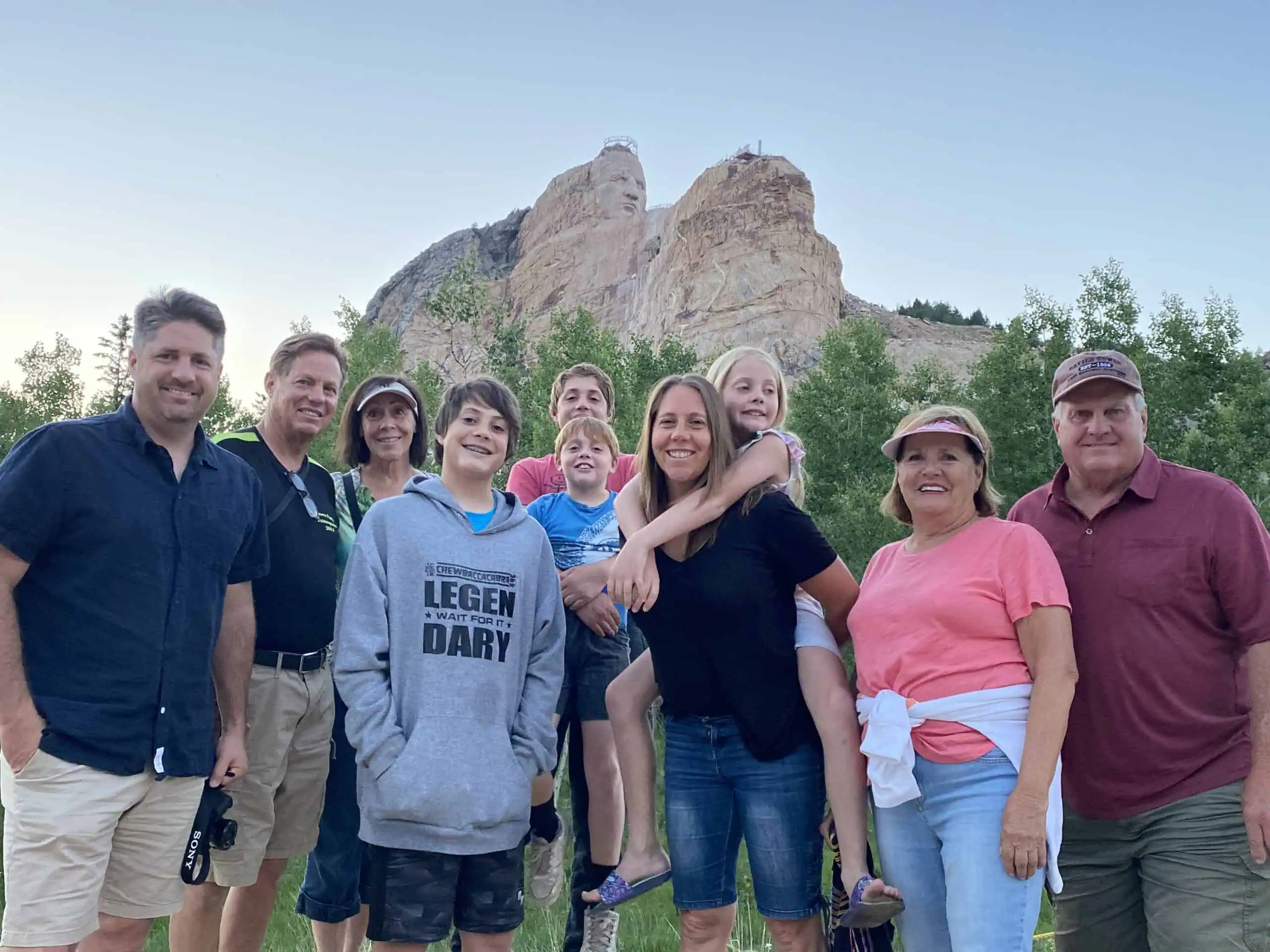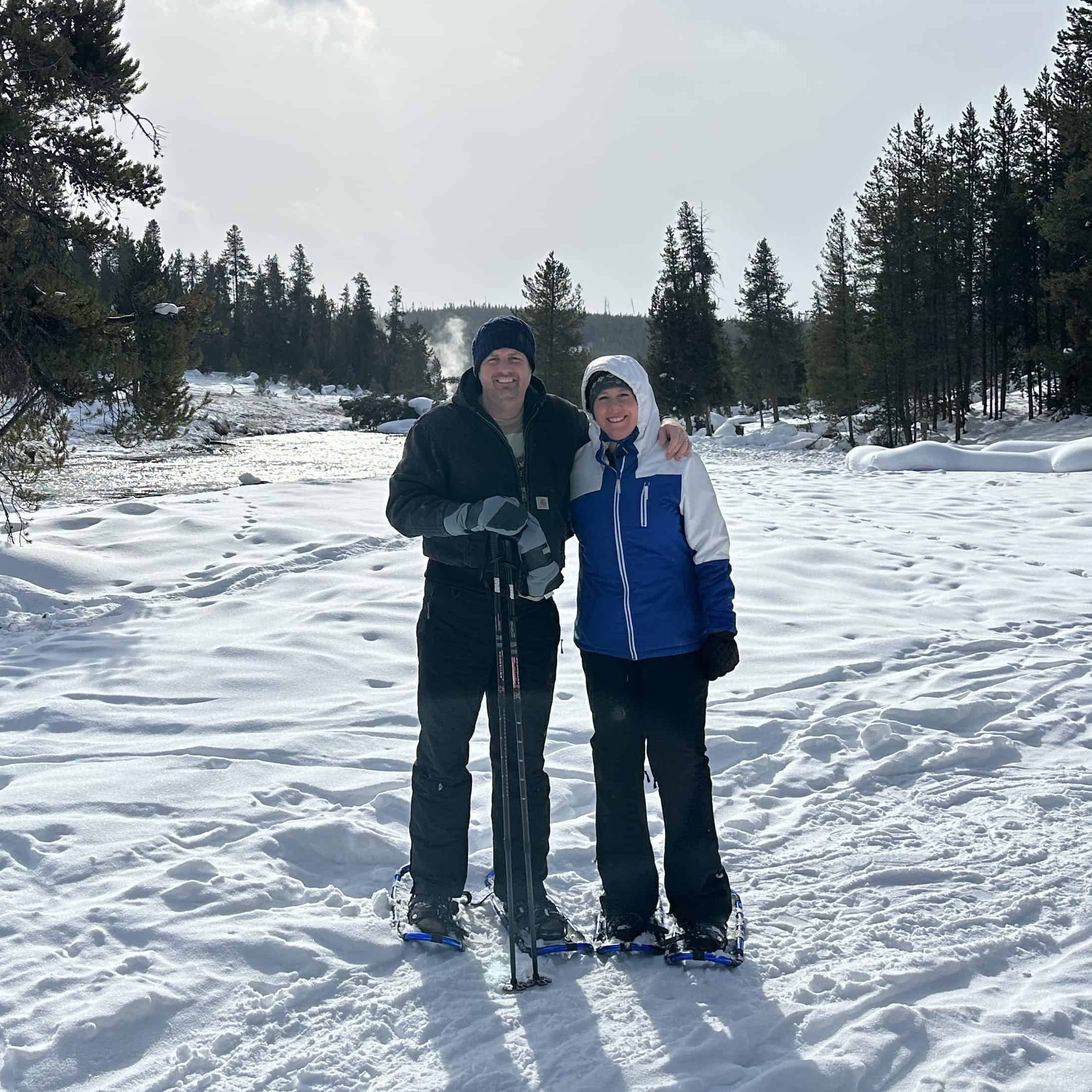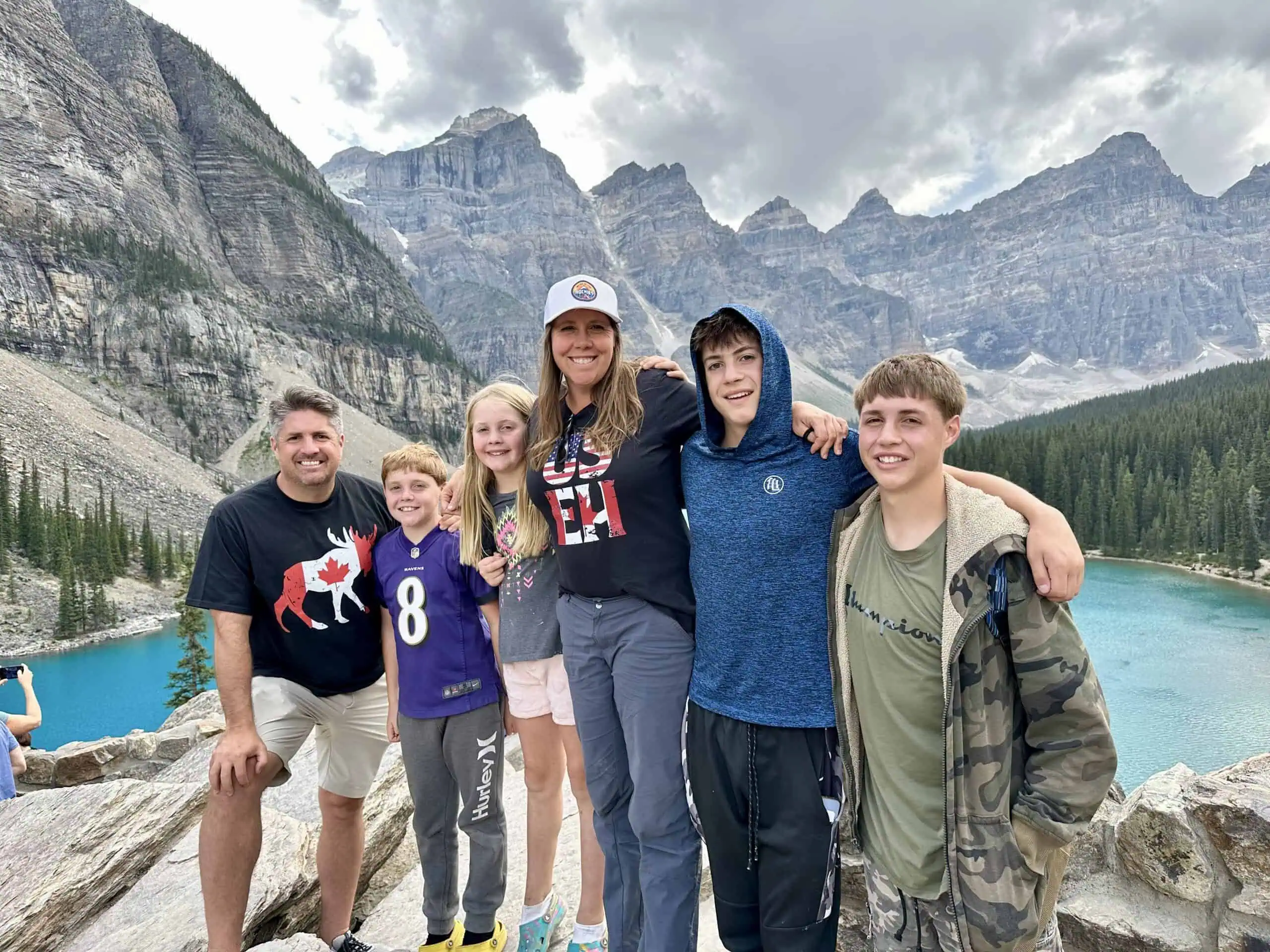Planning family travel to national and state parks is a major hassle – but it gets much easier if you follow in the footsteps of Matt and Cheryl Schoss. They started We're in the Rockies to share their expertise through videos and guidebooks, and the family business is now streaming on the Parks Channel! Here they share their story and some sage advice for park planners.
Charles Poe: I’m here with Matt and Cheryl Schoss, celebrities of the Rocky Mountains. I wanted to ask – with something like 60,000 subscribers on YouTube, how often are you recognized when you’re out and about?
Matt Schoss: It depends a little bit on the park and the area. But this last trip to the Grand Canyon, we probably got recognized about once a day. Yellowstone, sometimes 10 times a day.
Charles: Are we up to autographs yet? Or is it selfies people want?
Cheryl Schoss: Just selfies, and we’re always so grateful when people come up and say hi. It’s nice to meet people who are as excited about the parks as we are.
Matt: The other day we were driving home from Arizona, and we passed by Bryce Canyon and stopped for lunch. A family was using our guides, and stopped us and said hi. What really stuck out to me, though, was the daughter earlier that day had said, “Wouldn’t it be cool if we actually ran into Matt and Cheryl?” And then there at lunch they ran into us. That was kind of crazy.
Charles: That is very cool. Tell us a little bit about your background, yourselves and your family before the We’re in the Rockies phenomenon started.
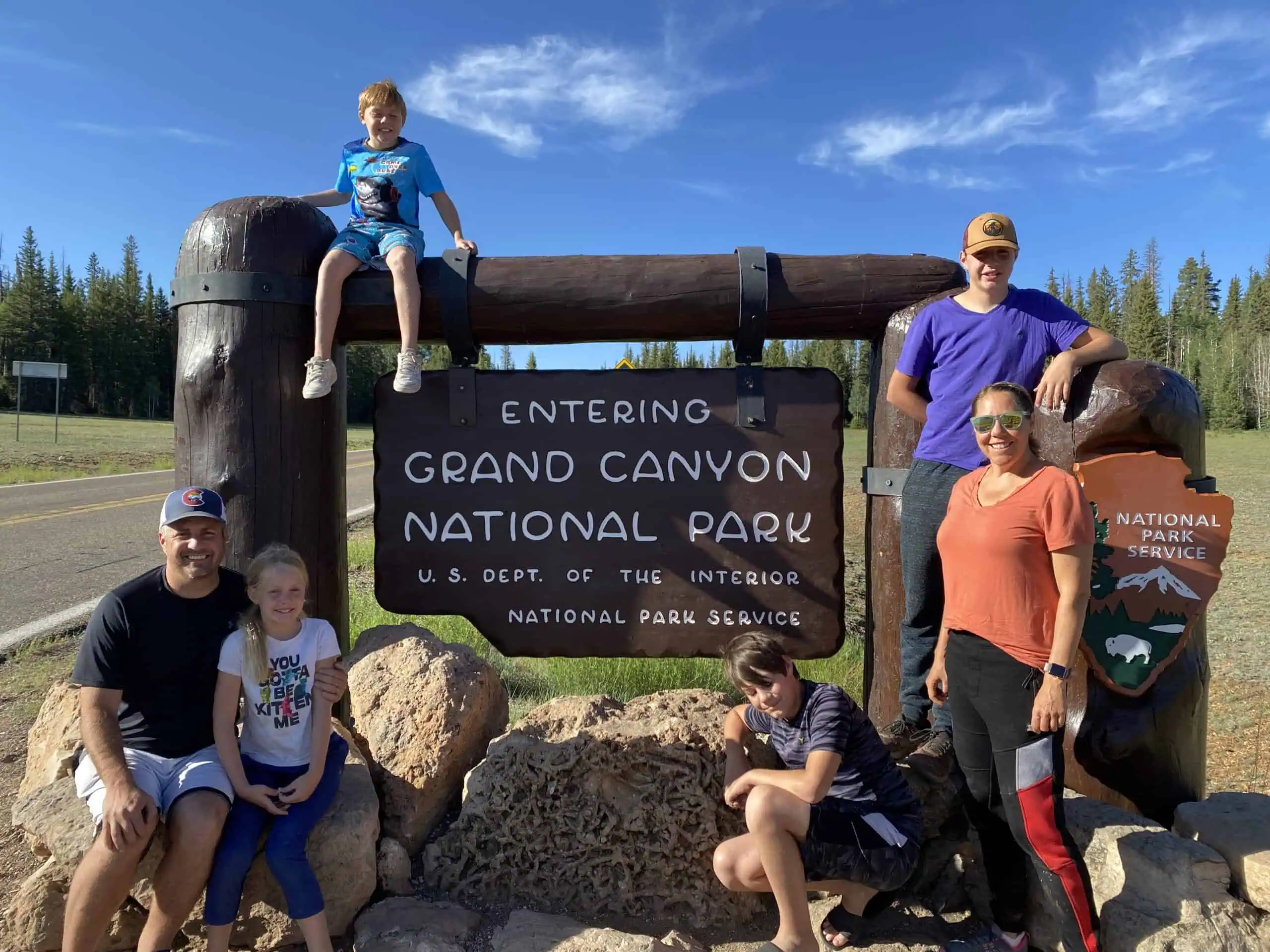
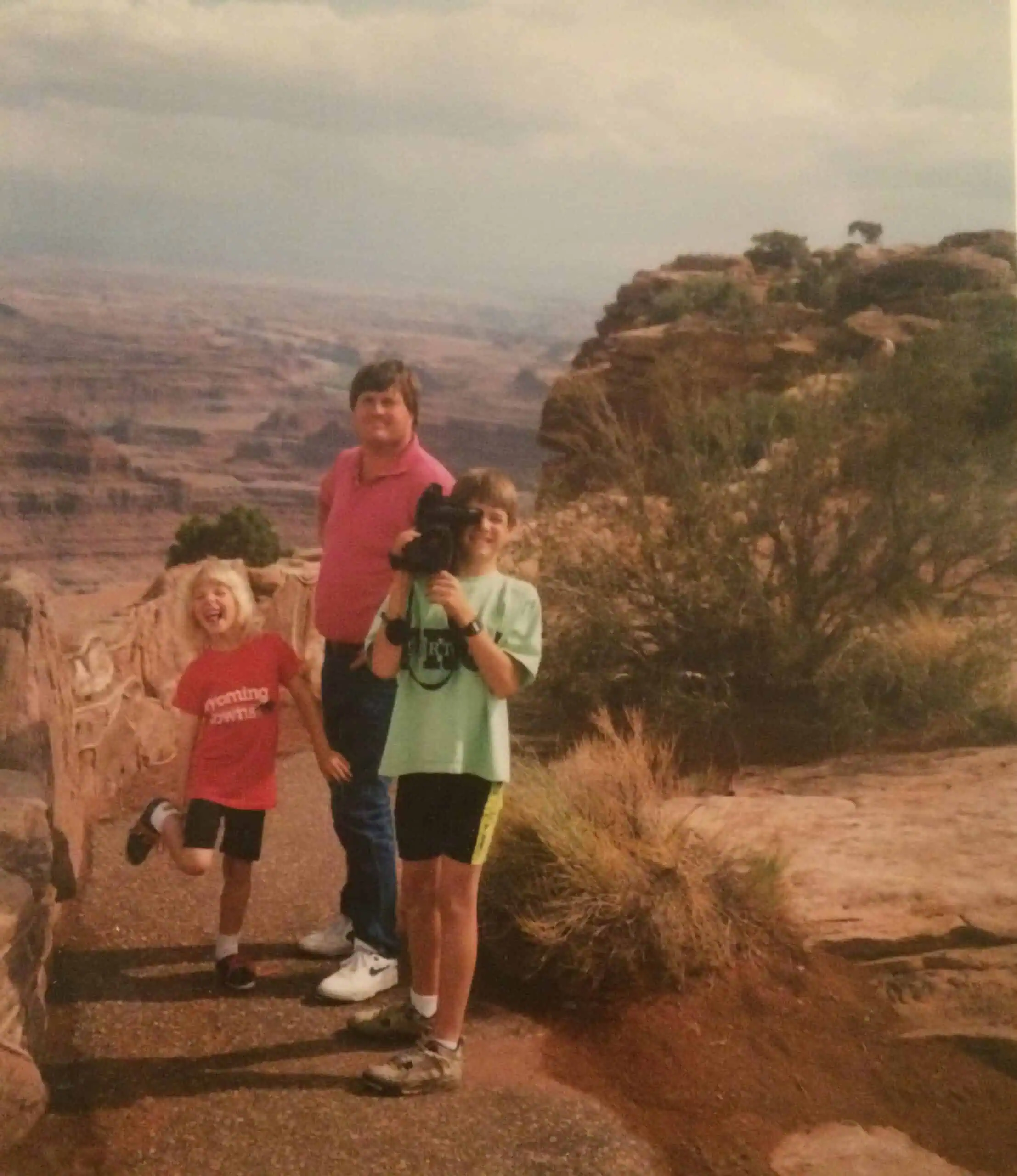
Cheryl: We both were born and raised in Utah, and we grew up in families that love the national parks. We would go every year. Our families would take us to Yellowstone. We went to Zion quite a bit, because both of those parks are about four hours from where we live. We continued to visit them when we had our own family. We’ve been married for almost 22 years now, and we have four kids. It’s a lot easier with teenagers than it is with toddlers.
We would go to the national parks because that’s what we could afford. We could drive there, and we would camp, and they were affordable vacations that we all enjoyed. Now our trips are a little bigger because we often take both sets of our parents who also live in Utah and get along with each other. So a lot of times, it’s a ten-person caravan with our family of six, and then both sets of grandparents.
Charles: Wow! Obviously, that adds to the trip planning challenges, which you guys have become experts on. When did you realize that you were starting to gain some knowledge that you wanted to share? Did it start with guidebooks or videos or both at the same time?
Matt: It was a process. I was looking for something else to do as a career, and I started teaching some adjunct history classes at Weaver State University. One of my sections was about the American West, and I decided to focus on national parks as a part of that section—preserving lands in the west, conservation and things like that. I realized I had a big collection of the National Park brochures they hand out when you come into the park. I started handing them out to all the students to look at, and I was surprised at the number of students who had not been to a national park, even though we’re here in Utah, and we’re very close to several national parks.
I realized I had a real passion for it. We had started looking at what we could do as an online business, something on the side that might be able to grow into something, and we were playing around with a few ideas. But we got home from Yellowstone one day and decided, well, this is what we really like talking about and doing. So let’s just try this, and that kind of blossomed.
Cheryl: We knew we liked to travel, and it started when we booked a trip to Atlanta, Georgia. Matt said, go ahead and plan it out. So I was on Youtube, and I was watching the videos, and I just thought, holy smokes, I don’t feel like I’m learning anything. I can see people vlogging through their trip, but they weren’t really helping me plan that trip for ourselves. We got to thinking, we need someone who will give us some good information to help us plan our trip.
We realized that not much of the population lives in the West, but we do. And we have a lot of knowledge about these parks, because we’ve been to them several times, because that’s what we’ve done growing up, and we still continue to do. We thought maybe we could help someone have a good trip out to Yellowstone.
Watch their “Complete Guide to the World’s First National Park”
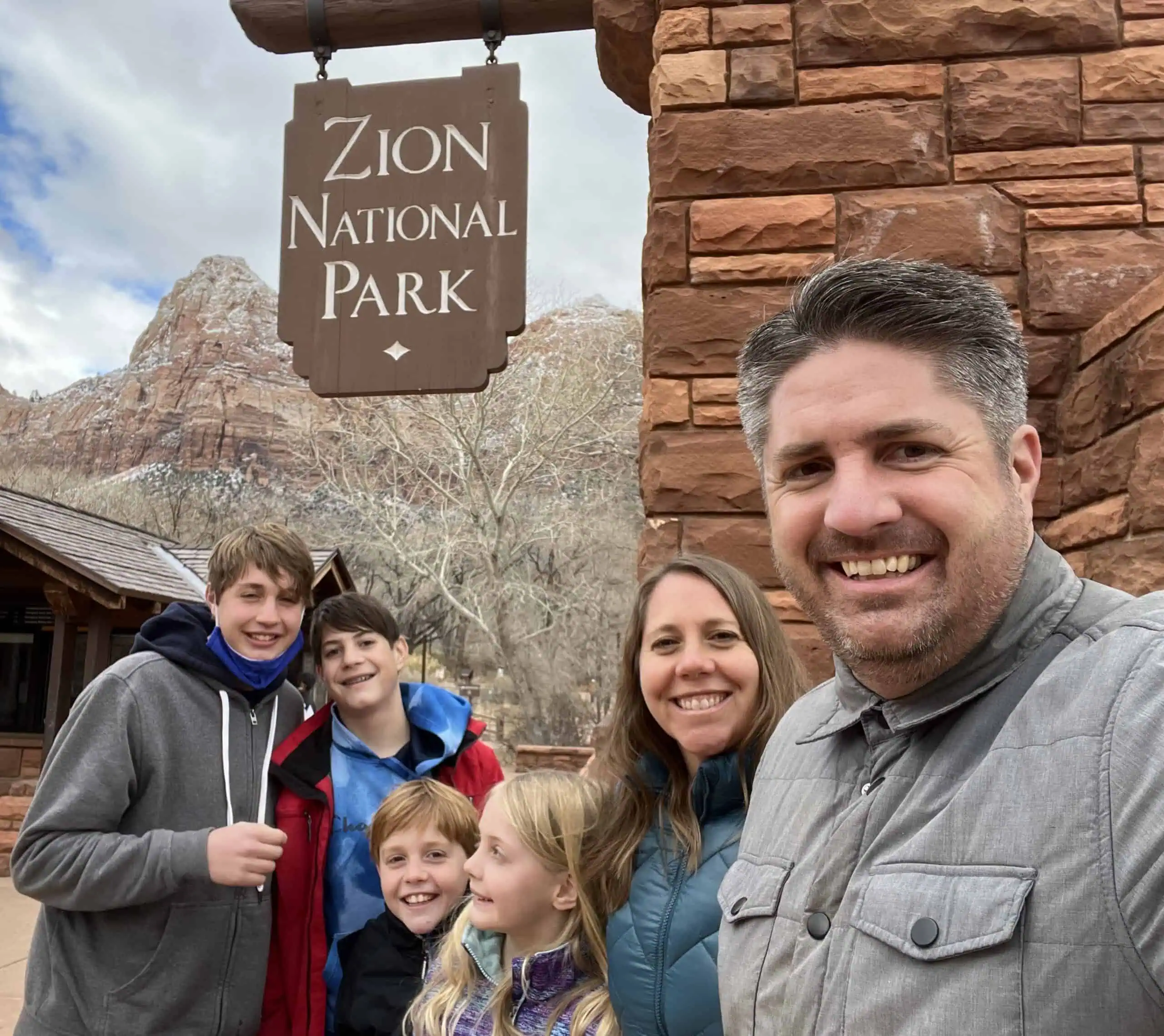
I think the breakthrough was Matt. He has always loved to edit videos—he’s done that for 20 years. One time he thought for fun he would try to make a video about how to visit Yellowstone and how to visit Zion. And he got out the map and he was breaking it down, and we actually got pretty good views on those videos, even though we were new creators, because Matt was actually helping solve a problem. He was teaching people like he would do in his classes. I think that’s how it all got started.
Charles: And you obviously found there’s a big demand for that—you’re solving a massive problem for people who want to plan a family trip. Why do you suppose it is so hard to plan a national park trip?
Matt: That’s a good question. I think planning any trip is actually kind of difficult, because, assuming you’re going somewhere brand new, you have no idea what the landscape is for that area. I do think Yellowstone, in particular, is interesting in that it’s so big. It’s just so big. People have a hard time wrapping their minds around it. There are five entrances, and they don’t know which one to use.
I thought it was really kind of funny that we got a lot of questions about driving in Yellowstone. Like, how long does it take to get places? And what if I break down? And things like this. So we did a video on how to drive in Yellowstone, and it got tons and tons of views. We thought that was kind of funny, because that’s not a question we would think about, because we’re used to going there. So obviously, we’re always trying to look at it from the travelers perspective.
The landscape is big out here. It takes a while to drive around and get places. It’s not very developed in a lot of these places in the Rockies. There are very small airports, so you’re doing these big, long road trips. It’s quite a bit that goes into it.
Cheryl: I think one of the challenges is that online, there are hundreds and hundreds of posts on everything. A lot of times it’s hard to sift through all that and find good information. We blog, we do Youtube, so we look and see what’s out there. And sometimes I have to say, wow, this person hasn’t spent much time in this park. Sometimes there can be information overload, and sometimes it’s hard to decipher how well-versed the person is on the place.
My observation when we visit the national parks is that when you get there, there’s actually a lot of good information there. They have great signage outside that’ll help you if you have half a day, if you have one day, and the maps they give you are really helpful. But I think finding that information before your trip is difficult. I think the National Park System does a good job putting alerts on their website of things that have changed. But sometimes it’s kind of fragmented, and it’s hard to put the whole picture together unless you’re actually there learning it.
Matt talks about how, especially in the West, people underestimate how far away things are from each other. Not just Yellowstone being a big national park, but if you’re going to Utah’s five national parks. You can drive across a lot of states back east in a couple of hours. But Utah’s big. It takes hours to get across Utah. A lot of these Western states are just big.
Charles: One of the things I love about your videos is that along with the insights and the information, you’re also not afraid to talk about your fails. I seem to recall, Cheryl, you had an experience with bear spray that didn’t turn out the way you hoped. What do you consider some of your biggest park fails?
Cheryl: The one that comes to mind was when we visited Banff. We have a guide for Banff, and we collaborated with The Mountain Town Ramblers. We used our guide-writing skills, and they helped us with the concept of visiting Banff—because, of course, we’re not gonna write a guide on a place we don’t know without bringing someone in to help.
Getting tickets is kind of a challenge, because sometimes you’re planning your trip a year in advance and you get your lodging, but then, the tickets for things you want to do aren’t available until a couple of months before. So we got a little bit behind the eight ball on getting our tickets to go to Lake Louise and Moraine Lake. Oh, my gosh, that whole day was a complete disaster. Our parents missed the bus. We couldn’t find a parking spot. Even the scramble to get the tickets. It was eight hours of trying to figure out our tickets before we left. It was craziness. It’s funny, because Matt’s mom loves everything and has a great experience, but she honestly does not like Lake Louise very much, because it was just so stressful.
So when I got home, I thought, this is a problem. I researched it down to the minutia, and I wrote a little freebie for people who are visiting to know all the options to get there, and when the tickets are opening up. I spent quite a bit of time solving that problem because I didn’t want anyone to have the same experience we had the first time.
I think it is actually good when our trips don’t go as planned. Because now we’re like, this is a challenge, and we want to make sure that this is crystal clear on how to visit for people who come after us.
Matt: We used to decide on a Friday morning, let’s go to Zion or Arches. Let’s just run off this weekend, and we’d just drive down there and get a camp spot, and see the park, and it was no big deal.
I think park visitation remained fairly steady for 20 years or more. It started exploding when the Baby Boomers started retiring. And social media—which we’re a part of—helps make it more popular for sure. Now that’s another challenge, all this preparation. Because there are shuttles, there’s reservations, there’s all that, and that stresses people out. You don’t want to go all the way out there, and then, oh, we can’t go do that thing because we needed to get advanced reservations. It takes quite a bit of time to plan these things out ahead of time.
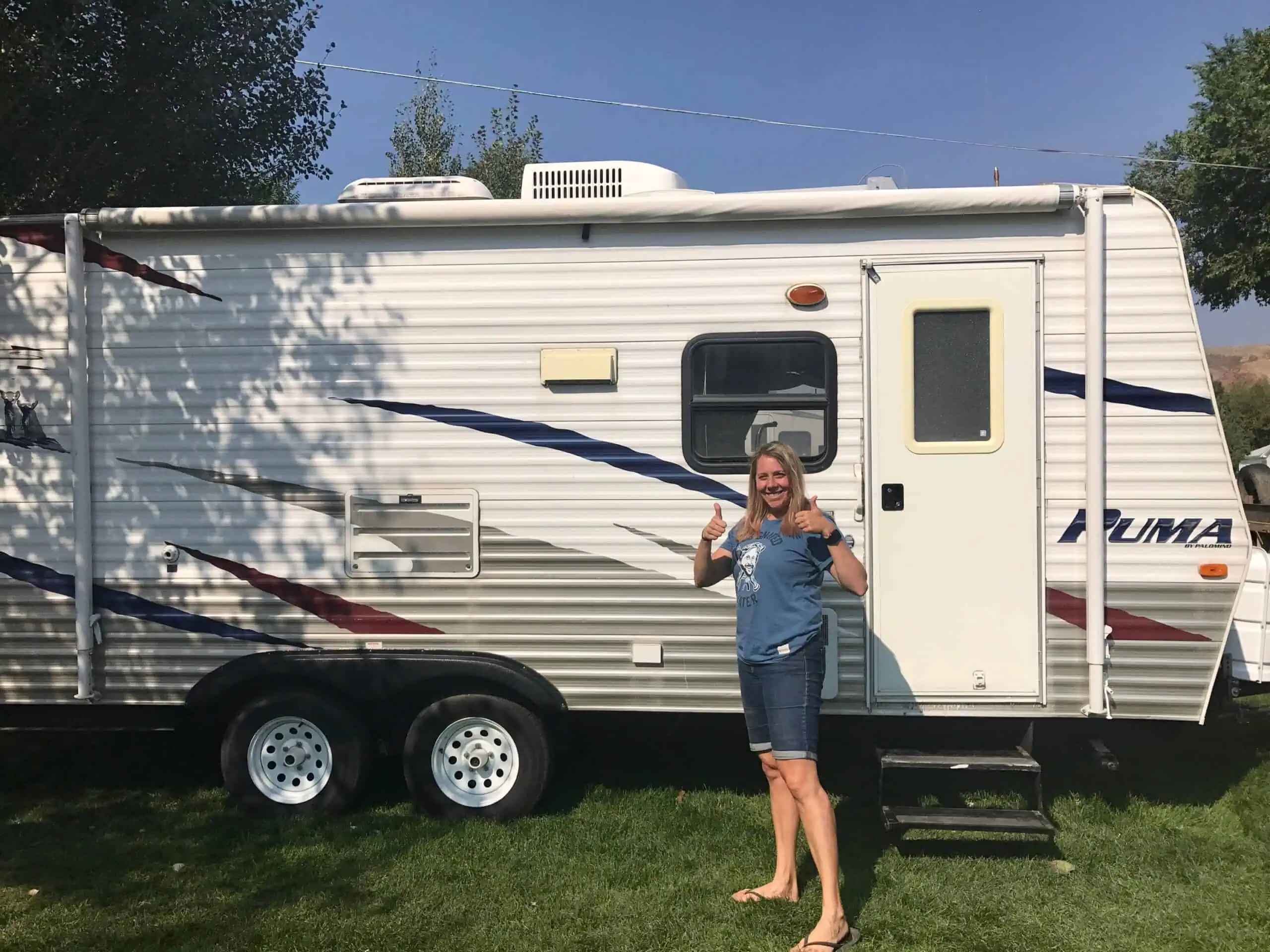
Cheryl: I’m sitting here thinking about all the epic mistakes we’ve made. Another one was when we got our trailer a few years ago. I was so gung ho to take our trailer everywhere, I planned back-to-back-to-back vacations. And Matt said, “Cheryl, this is a little too much,” and I’m like, “No, it’s not, the kids are gonna love it!”
And by vacation number five it was a total meltdown. You hear about the families who say, “I’m gonna turn this car around!” We legit did that. The kids were miserable. We were miserable.
Charles: What was the breaking point?
Matt: Five weekends in a row. On the fifth weekend we went up to Yellowstone and our kids were so miserable that we actually drove home from Yellowstone a day early.
Cheryl: Yup. I remember we were walking around the Old Faithful Geyser Basin and the kids were slogging across and getting in fights. I was afraid they were gonna push each other into the geysers.
Charles: Too much of a good thing. What are you gonna do?
Cheryl: You see these travelers melting down because they were overly ambitious, and they pushed their group too far. They’re making them wake up at 6 am, and they’re on these 18-day trips.
We will never forget the time we were riding bikes through Rome, and we were having a delightful time. It was the highpoint of our trip. It was amazing. And we look over, and there’s a man on his cell phone, beet red in the face yelling at his family, and you could hear him saying, “You guys have complained the whole trip!”
Matt: It was loud, and our whole family remembers it and talks about it to this day. I just keep thinking, I don’t ever want to be like that. I can’t ever get to that point.
Cheryl: Travel is not without its challenges, even a well-planned trip. I can think of plenty of times when there were tears in the trailer because things haven’t worked out well.
Charles: What do you typically advise in terms of how far in advance to plan a trip? People are buying your guide books, and some are meticulously planning well in advance. Do you have general guidance, especially for the big parks?
Matt: That’s a great question. The typical advice is to start a year early, because the actual lodges that are run by the concessionaires within the national parks usually open up a year in advance. So the people who are really prepped who like to stay in those lodges in the park are usually booking those up a year early.
Most people don’t start planning their trips until right after Christmas. We notice a spike literally the day after Christmas. People are starting to think about next year. So that’s a pretty good time to start getting everything into place, though you might not be able to get the lodges. Each national park only has a handful of lodges—some only have one, some have none—that are actually located within the park.
But then there are all these little towns outside the park where you could typically get accommodations. It’s usually fine to start booking those in January, and even into February.
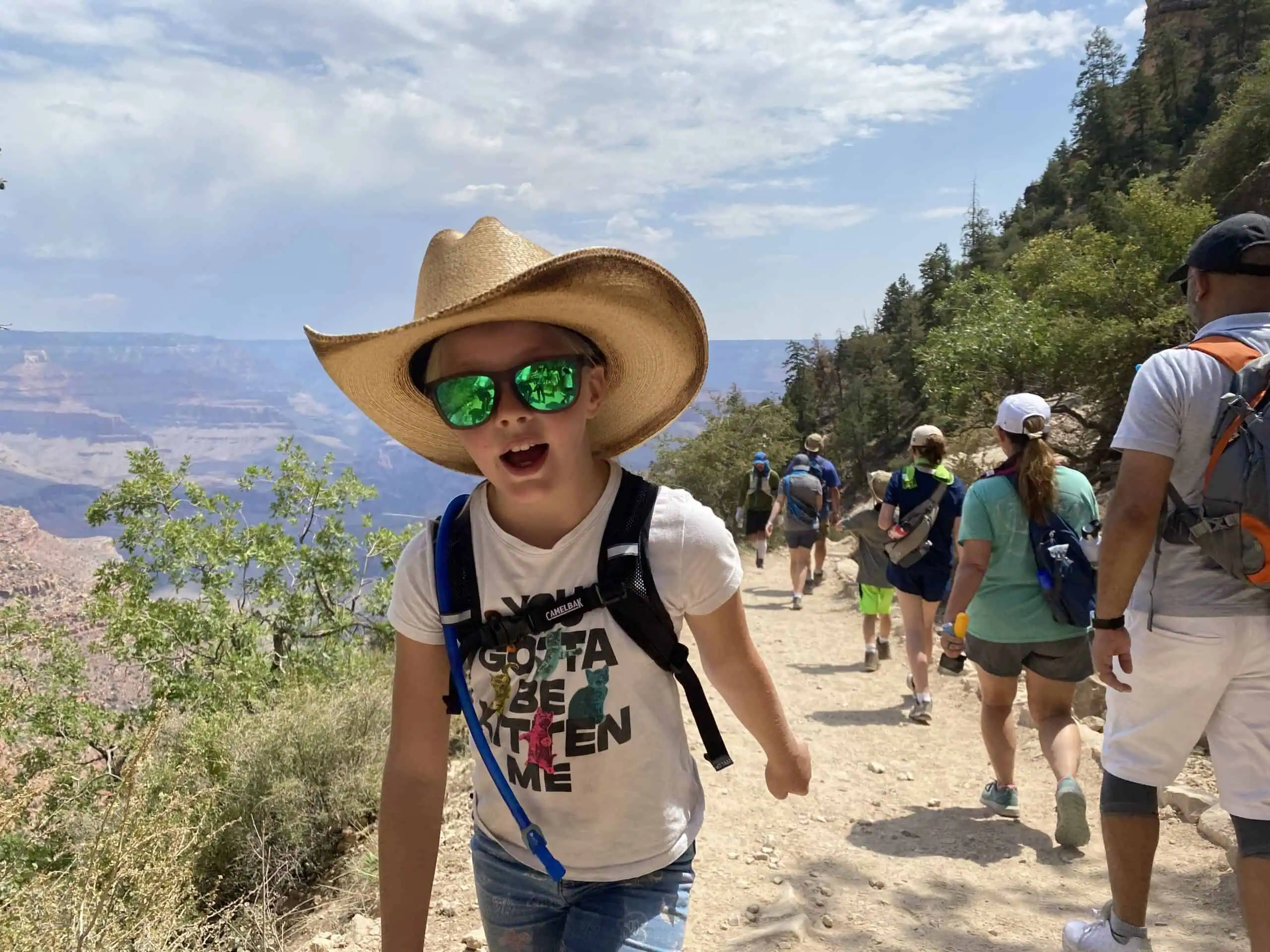
Cheryl: Well, actually, we had kind of an aha moment this year. We started planning our trips for 2024 in October. Normally, we’re not that far ahead. But in September we were working on a lodging guide for Grand Teton, and we were talking to the owners of various hotels. One of the tips they gave us was that right now is a great time to book for the next year, because they haven’t raised their prices for the upcoming year and there’s a lot of availability. I was surprised at the great deals we were able to get on our lodging.
The National Parks have their prices kind of fixed. But if you’re staying outside the park, you’re able to really snag some better values, and you have so much more to choose from. It’s just such peace of mind to know some of those big nuts and bolts of your trip are already taken care of, so that you know you have a place to stay at least.
The other little trick I’ve learned is that even though I can book my lodging really far in advance, I may not be able to book tickets to Jewel Cave for example, for several months. A lot of those timed entry reservations don’t open up until later. So when I book those hotels, I also make a note in my planner so I don’t forget to go back and do that.
Matt: One last thing is the campgrounds typically open up six months in advance. Typically, you’re okay in the January timeframe. But if you want to stay in those lodges and get better rates do it earlier.
Cheryl: Sometimes people think they can’t travel because they haven’t planned months in advance. It’s best to plan ahead, but it seems like there is always availability in hotels in the border cities outside the parks. You may pay a pretty penny for your lodging, or if you’re camping, you might have to stay in a BLM (Bureau of Land Management) or forest service campground. But that’s okay. You might drive a little further.
The other thing I’ve learned is that even parks with reservations save 20-30% of those reservations for night before people. We’ve known plenty of people who were able to get their timed entry tickets the night before.
Matt: Timed-entry reservations are typically just during the busy hours of say, 9 a.m. to 3 p.m. We’ve gone in after the busy time and had a great time. Late in the day is great because people start to clear out, and then you can just go in there and do whatever you want.
Cheryl: And you don’t have to wake up at the crack of dawn. I love being in the parks first thing in the morning, but that’s not for everybody.
Charles: You mentioned the distances in Utah. You have become experts on road trips. What are your five most important tips that you think about when you’re planning a road trip?
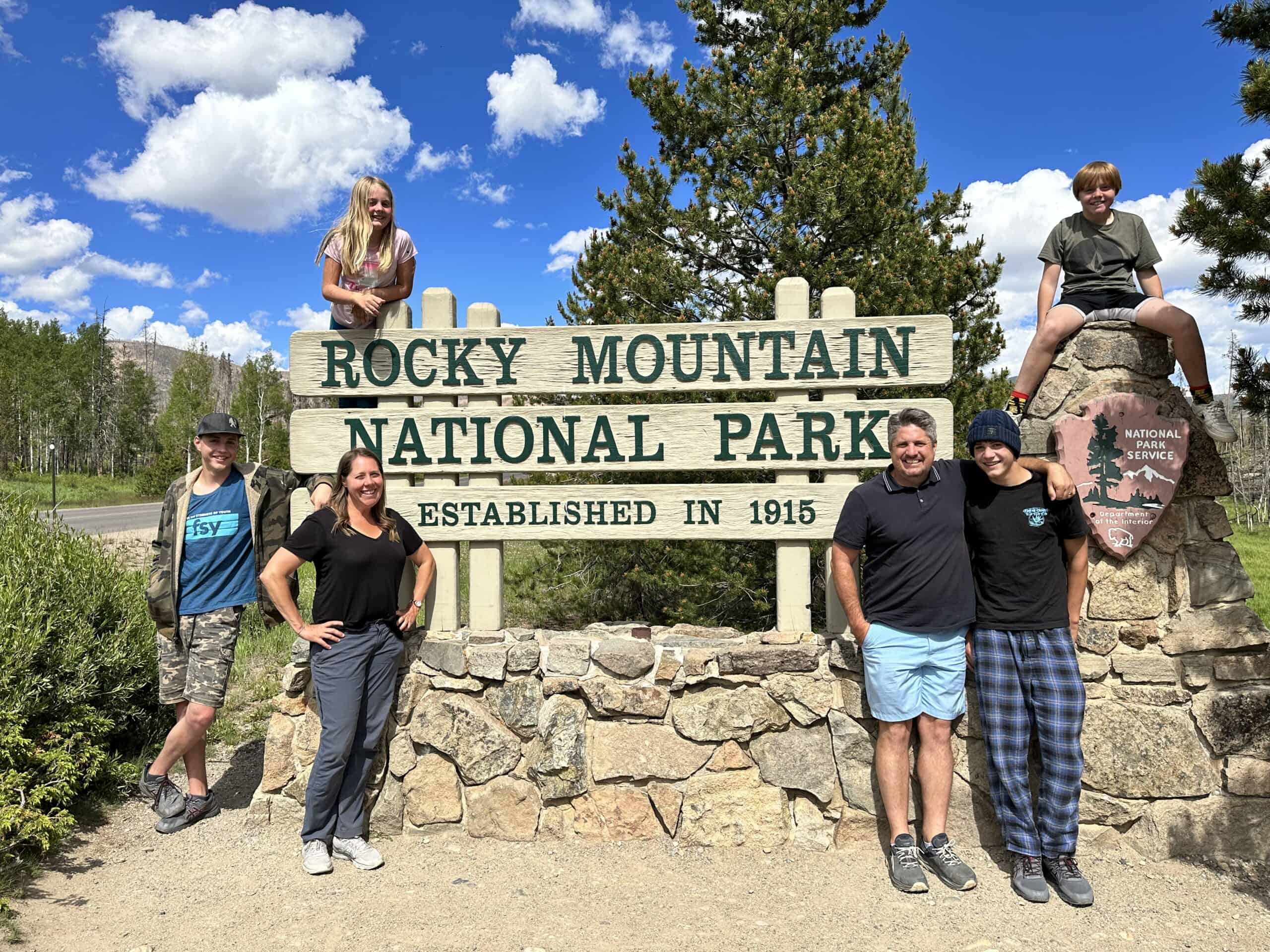
Matt: Oh, that’s good. The first tip I would say is that home bases typically don’t work. We talk to a lot of people who want to have a home base for their trip, where they stay in one place for a long time, and then they go out and do these day trips. We talked to somebody who was driving three or four hours, one way, and then would come back because they wanted to have a home base.
We usually advise you to plan out your days so that you can move from one location to the next, and see things along the way. That’s the way I do it. Now I know that’s not for everybody, but that’s the way I like to do it. You do have to change locations every night or every two nights. It’s nice if you can get two nights in a row. But I like to do things as I progress.
Cheryl: I do think that sometimes this requires being thoughtful. We have a rule that we don’t like to drive more than an hour each way to whatever we’re doing. We wrote a guide to a Colorado road trip, where we visited ten different places. We actually figured out a way where you only have to switch locations three times if you’re hitting Rocky Mountain National Park along the way. Think about how far you’re willing to drive every day. Don’t put in so much driving that you are missing out on some of the fun.
One of my big tips about a road trip is that I like to plan on eating out once a day, and having a picnic once a day. Sometimes we have a picnic dinner, because you need flexibility. It’s nice to have a meal in a restaurant and not have to worry about it, but having to stop and get food is very inconvenient and can really mess up touring around the parks. Packing your own food can save you a lot of money. I also think it’s really important to try to eat something that’s local once in a while. It adds to the experience.
We just stayed at a really nice bed and breakfast in the Grand Canyon, and the guy who owned it prepared the most amazing food for us in the morning. It’s one of the most memorable things about our trip. And we’ll never forget eating breakfast at El Tovar. That’s another good little tip: breakfast is always cheaper, so if we want to go to a restaurant with a good view in a national park, we’ll usually go for breakfast because it’s cheaper and you don’t need reservations.
Matt: Okay, I have two more tips. Next one is to fill up on gas. Out in the West, you can be driving for hundreds of miles without seeing a gas station. So whenever we get below half a tank, I start to think about it. Then, if we have to stop and use the bathroom, just fill up now because we’re driving across the Arizona desert or something, and you just never really know. You don’t want to get into a situation where you’re 50 miles from the next gas station and you have less than a quarter tank. That’s happened to me before. If you’re coming from the coast, it can be hard to understand how wide open and spread out the West is. It’s crazy how remote it can be out here.
The other thing is, even though I go from place to place. I kinda know, after about three days of that maybe four, we do need a spot where we stay a couple of days. We did a big trip through Yellowstone, and we drove all the way up to Theodore Roosevelt National Park, in North Dakota—an underrated cool little spot—and I thought, we need a break right here. We’re going to need to spend a couple of nights here because our family is going to be worn out. We do try to build in some days where we can just chill out.
Cheryl: For number five, on a road trip, it’s so important that you have spent a lot of time preparing for it. I’m not saying you have to have an itinerary and stick to it every second. If you have a plan, you know about how long things take and the best things to see. And then, if you see an animal on the side of the road and you wanna stop and look at it, you can say, we were gonna go to this geyser basin, but this is so cool, and I’m okay to miss that.
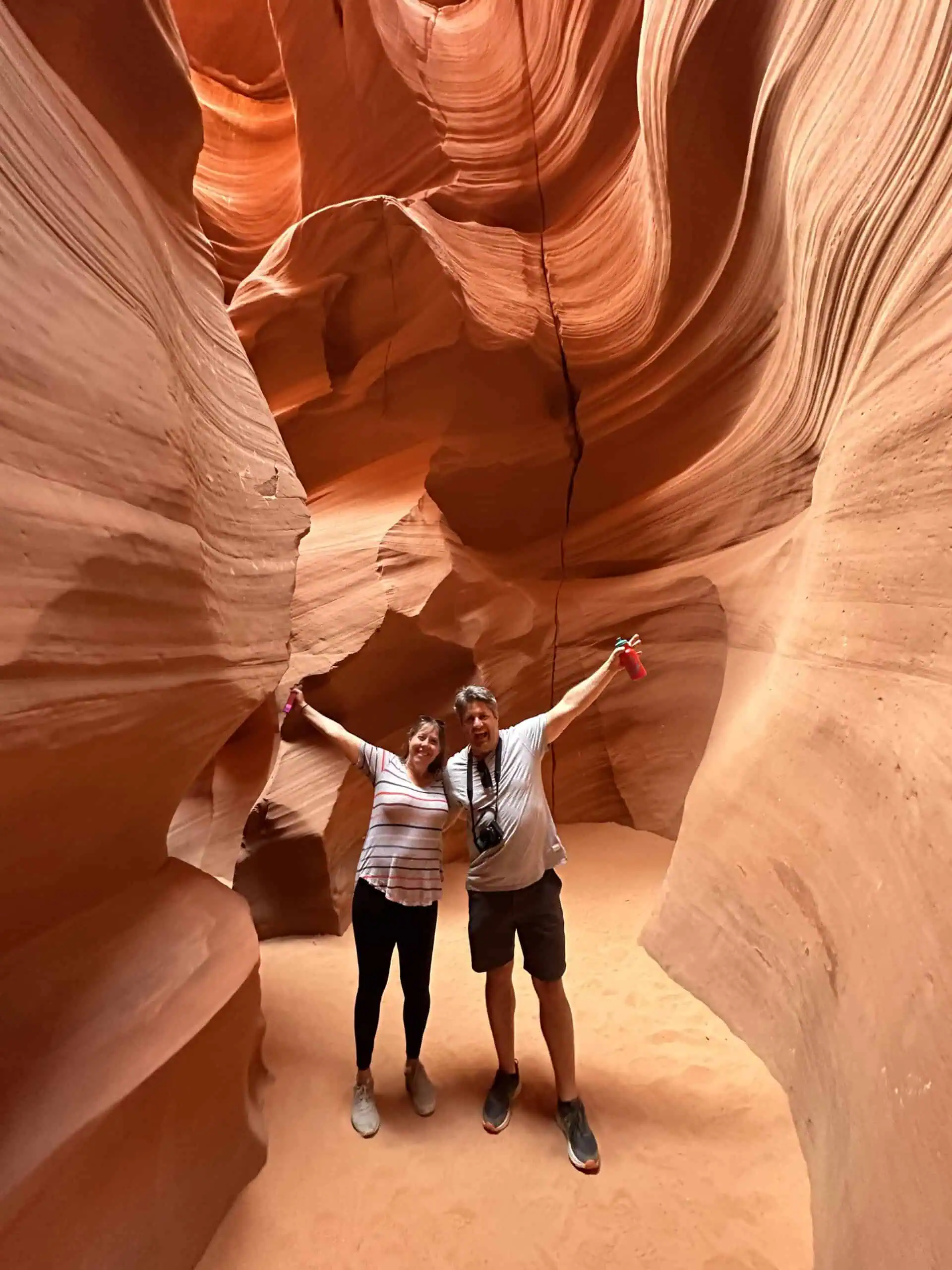
When you have a plan, and you’re educated about where you’re going, it allows you to be so much more flexible. It’s kind of like a budget. Some people think budgets are limiting, but actually they enable you to make wise choices. I think you have to make your travel time budget. Know what you want to do, know what’s the most important so you don’t get sidetracked on things that may not really bring the most value to your trip.
Charles: It’s fantastic advice. You specialize in Utah and the West. I’m curious if you are keeping track of how many of the big national parks you’ve been to and are you trying to get to all of them? Or is that not on the bucket list?
Matt: Oh, that’s a good question. I see a lot of people who are trying to check off all 63 national parks. I’ve never really had a goal to do that. My mom and I have had more of a goal to see the 400 plus National Park Service sites. We’re always counting up how many of those we’ve done. So I just printed off the list the other day and I think I’m up to around 80 or 90 of those sites. There are a lot more to go. I’m not a perfectionist about it. I’m probably not gonna fly out to some of the remote places in Alaska anytime soon, but I like to check those off.
We just went to Lake Powell in Utah and Arizona, and we took a boat ride out to Rainbow Bridge National Monument. The only way to get there is to hike 14 miles, or to take a boat ride for the day out to this national monument. This is a really remote one. That’s another national monument I got to check off, and for me those have always been pretty much just as special as the national parks. There’s some incredible national monument sites out there, just some really awesome places.
I like the history sites as well out East. There are plenty of history sites out here with a lot of native American ruins in Arizona and Colorado and Utah. Those are the ones I think about. Anytime I go on a vacation. I was in Minnesota a couple of years ago, and I’m always looking—are there National Park sites around?
Charles: So if you had one park and only one park that you could visit, which would it be?
Matt: I would go with Yellowstone mainly for the variety. It just has so much. You get the wildlife, the canyons, the geysers, the mountains, the valleys, the lakes, the rivers. It’s so big, and it has so much.
I think Zion is probably the prettiest place I’ve ever been. And Cheryl thinks Glacier is probably the prettiest place that she’s ever been. But if I had to choose one, it’s gotta be Yellowstone for the sheer size and variety.
Cheryl: We always say it’s like five national parks in one.
Charles: In terms of hidden gems—or ones that are less crowded and popular—what do you advise? Any favorite places that are off the radar?
Cheryl: Well, Capitol Reef is one of my all time favorite national parks. I love how unique it is, because there are orchards in it. I mean what national park has fruit orchards? It’s so interesting to me. It might be because my family is a fruit family—my grandpa had a big orchard, so maybe that’s why I like it so much.
The rock in Capitol Reef is so red, and it’s an easy park to visit. There are a lot of three-mile hikes. There are incredible drives. The drive out to Capitol Gorge is the best driveable slot canyon I’ve ever seen. I’m always thinking about accessibility for people who can’t hike, and this is a slot canyon experience without having to hike and I love that about it.
The other thing off the beaten path are the state parks in Utah, speaking of road trips—and this would be my tip number six. The national parks like Arches and Zion are challenging because they’re crowded. You have to be on your A game, and get up early and so on. When you go to the state parks between these national parks, that’s your chance to catch your breath.
They saved us on our road trip. We went to Kodachrome Basin and Goblin Valley. We went to Gunlock State Park, which had a waterfall in the desert that year. We love Custer State Park. The state parks are great and allow you to get away from the crowds and still see some really beautiful stuff. They can’t make the entire west a national park, but there’s a good chunk of Utah that could be a national park.
Matt: Okay, I have three more for you. Theodore Roosevelt National Park is totally underrated. It’s got a very cute, charming little gateway town, Medora, North Dakota, that people love. The Madura Musical is a fun show in an outdoor amphitheater.
Mesa Verde National Park is awesome. It’s the most amazing Native American cliff dwellings that you’ll see. I just absolutely love that one. It’s very interactive. You’re climbing on ladders. You’re going into the ruins. There’s scenery there.
Then my last one that just keeps sucking me in is Canyonlands in Utah. It gets overshadowed by Arches, but interestingly, Canyonlands was actually a national park before Arches. Everybody thought Canyonlands was the draw to Moab at the time that they made it. Part of the reason it’s less visited is because they’ve kept it a little more rugged and have kept the accessibility kind of limited. It’s unlike anything that’s out there. It keeps drawing me back because I’ve gotta find out what is out in this untouched wilderness. It draws backpackers and real deep backcountry people. Even jeepers. You can go jeeping way off the beaten path if you have the right vehicle, and just so far out there. It takes forever to explore, because it’s a backcountry park.
Charles: Last question. What is your next adventure?
Cheryl: Black and yellow road.
Matt: We’re going to the Black Hills and Mount Rushmore area which has six national park sites. And then we’re going to Yellowstone after that in one big trip.
Our next new adventure is to the Washington parks this year. We’ve had a lot of people asking us for guides to Olympic and Mount Rainier and parts of the Pacific Northwest as well as Yosemite. So we’re gonna start branching out and try to explore those areas as well.
Charles: Great. Well, listen. Your guidebooks have been invaluable to so many people, and it’s great to see your celebrity growing and growing, and thanks so much for taking the time to tell us a little bit of the backstory.
Matt: Thank you for having us.
